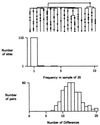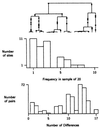Genetic traces of ancient demography
- PMID: 9465125
- PMCID: PMC19224
- DOI: 10.1073/pnas.95.4.1961
Genetic traces of ancient demography
Abstract
Patterns of gene differences among humans contain information about the demographic history of our species. Haploid loci like mitochondrial DNA and the nonrecombining part of the Y chromosome show a pattern indicating expansion from a population of only several thousand during the late middle or early upper Pleistocene. Nuclear short tandem repeat loci also show evidence of this expansion. Both mitochondrial DNA and the Y chromosome coalesce within the last several hundred thousand years, and they cannot provide information about the population before their coalescence. Several nuclear loci are informative about our ancestral population size during nearly the whole Pleistocene. They indicate a small effective size, on the order of 10,000 breeding individuals, throughout this time period. This genetic evidence denies any version of the multiregional model of modern human origins. It implies instead that our ancestors were effectively a separate species for most of the Pleistocene.
Figures









References
-
- Swisher C C, Rink W J, Anton S C, Schwarcz H P, Curtis G H, Suprijo A, Widiasmora Science. 1996;274:1870–1874. - PubMed
-
- Nei M, Graur D. In: Evolutionary Biology. Hecht M K, Wallace B, Prance G T, editors. Vol. 17. New York: Plenum; 1984. pp. 73–118.
-
- Klein R G. J World Prehist. 1995;9:167–198.
-
- Lahr M M. The Evolution of Modern Human Diversity. Cambridge, U.K.: Cambridge Univ. Press; 1996.
MeSH terms
Substances
LinkOut - more resources
Full Text Sources

